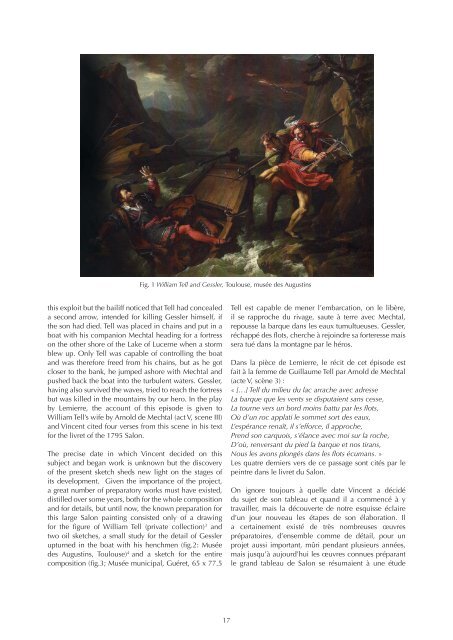You also want an ePaper? Increase the reach of your titles
YUMPU automatically turns print PDFs into web optimized ePapers that Google loves.
Fig. 1 William Tell and Gessler, Toulouse, musée des Augustins<br />
this exploit but the bailiff noticed that Tell had concealed<br />
a second arrow, intended for killing Gessler himself, if<br />
the son had died. Tell was placed in chains and put in a<br />
boat with his companion Mechtal heading for a fortress<br />
on the other shore of the Lake of <strong>Luc</strong>erne when a storm<br />
blew up. Only Tell was capable of controlling the boat<br />
and was therefore freed from his chains, but as he got<br />
closer to the bank, he jumped ashore with Mechtal and<br />
pushed back the boat into the turbulent waters. Gessler,<br />
having also survived the waves, tried to reach the fortress<br />
but was killed in the mountains by our hero. In the play<br />
by Lemierre, the account of this episode is given to<br />
William Tell’s wife by Arnold de Mechtal (act V, scene III)<br />
and Vincent cited four verses from this scene in his text<br />
for the livret of the 1795 Salon.<br />
The precise date in which Vincent decided on this<br />
subject and began work is unknown but the discovery<br />
of the present sketch sheds new light on the stages of<br />
its development. Given the importance of the project,<br />
a great number of preparatory works must have existed,<br />
distilled over some years, both for the whole composition<br />
and for details, but until now, the known preparation for<br />
this large Salon painting consisted only of a drawing<br />
for the figure of William Tell (private collection) 3 and<br />
two oil sketches, a small study for the detail of Gessler<br />
upturned in the boat with his henchmen (fig.2: Musée<br />
des Augustins, Toulouse) 4 and a sketch for the entire<br />
composition (fig.3; Musée municipal, Guéret, 65 x 77.5<br />
Tell est capable de mener l’embarcation, on le libère,<br />
il se rapproche du rivage, saute à terre avec Mechtal,<br />
repousse la barque dans les eaux tumultueuses. Gessler,<br />
réchappé des flots, cherche à rejoindre sa forteresse mais<br />
sera tué dans la montagne par le héros.<br />
Dans la pièce de Lemierre, le récit de cet épisode est<br />
fait à la femme de Guillaume Tell par Arnold de Mechtal<br />
(acte V, scène 3) :<br />
« […] Tell du milieu du lac arrache avec adresse<br />
La barque que les vents se disputaient sans cesse,<br />
La tourne vers un bord moins battu par les flots,<br />
Où d’un roc applati le sommet sort des eaux,<br />
L’espérance renaît, il s’efforce, il approche,<br />
Prend son carquois, s’élance avec moi sur la roche,<br />
D’où, renversant du pied la barque et nos tirans,<br />
Nous les avons plongés dans les flots écumans. »<br />
Les quatre derniers vers de ce passage sont cités par le<br />
peintre dans le livret du Salon.<br />
On ignore toujours à quelle date Vincent a décidé<br />
du sujet de son tableau et quand il a commencé à y<br />
travailler, mais la découverte de notre esquisse éclaire<br />
d’un jour nouveau les étapes de son élaboration. Il<br />
a certainement existé de très nombreuses œuvres<br />
préparatoires, d’ensemble comme de détail, pour un<br />
projet aussi important, mûri pendant plusieurs années,<br />
mais jusqu’à aujourd’hui les œuvres connues préparant<br />
le grand tableau de Salon se résumaient à une étude<br />
17
















